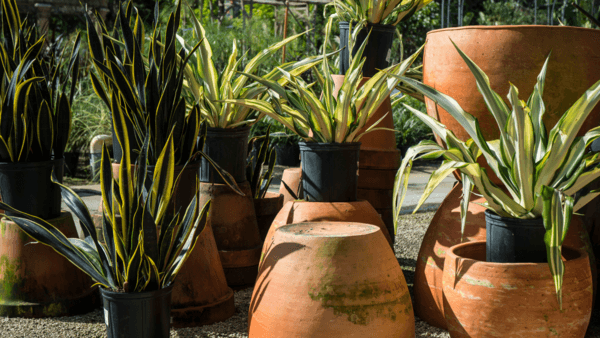Good news, we are in March and you can slowly but surely say goodbye to winter. Before doing whatever you like in May, take advantage of the arrival of spring and its milder climate to rethink your terrace and the plants that will benefit from your beautiful sunshine.
Need ideas? Last week we told you about how to decorate your decking area and planters were part of the list. This week, take advantage of our suggestions for plants for sunny terraces! Don't thank us, it's our pleasure to brighten up your outdoor space!
Only a few plants are incompatible with a south-facing orientation, however, avoid plants that require too much water, such as semi-aquatic plants like papyrus, mint, parsley, or sorrel. Similarly, avoid shade plants like Japanese maple, rhododendron, camellia, or heather.
For the rest, choose resistant plants that like soils that are rather dry and without excess water. Don't forget to water them more often to prevent them from being burnt too quickly by an excess of sun. Do you want some ideas now? Perennials, succulents, annuals... Well, we have what you need in stock. Enjoy!
Which plant to put on a sunny terrace?
For regions with mild winters, perennials such as bougainvillea will delight you with their beautiful blooms. The same goes for a plant with many advantages, enjoying a well-sunny exposure and sheltered from the wind: amaranth. Its upright or cascading spike-shaped blooms and its foliage that can be very colorful will easily embellish your beautiful terrace.
For regions with cold winters, we recommend the resistant oleander, or even the palm tree that will bring a touch of exoticism to your terrace. Finally, among the plants that adapt to all types of climates, you have at your disposal the California lilac and its delicate perfume. Indeed, its blue color will offer freshness and serenity to your terrace just like an abundant bloom.
In general, its flowers group together in lovely small clusters and appear on the branches in spring or summer, depending on the species. You can also put on a sunny terrace plants called "succulents" such as sedums and asters, but also Mexican oranges and citrus fruits such as lemon or clementine trees.
Let's finish this little overview with the aromatics (...) perfect for cooking and for good Mediterranean scents:
Rosemary, an aromatic herb with needle-like leaves commonly used in Mediterranean cuisine, particularly in dishes with lamb or poultry.
Thyme, a small-leafed herb with a strong flavor that is often used in French and Italian cooking, especially in tomato-based sauces and stews.
Laurel, also known as bay leaves, is a popular herb used in Mediterranean and Latin American cuisine to add depth and complexity to soups, stews, and sauces.
Sage is a perennial herb with velvety gray-green leaves that is commonly used in European and Mediterranean cooking to flavor poultry, pork, and stuffing.
Lavender is a fragrant herb with purple flowers that is often used in desserts and teas, as well as in savory dishes in French and Mediterranean cuisine.
What flowers for a south-facing terrace?
Is your terrace facing south? Choose annuals and flowering plants. Thanks to the sun, you will have almost continuous blooming. However, be careful not to mix colors too much to avoid a patchwork effect. Flowering plants are also a good alternative, such as Agatheas. These, also known as Cape Asters or Blue Daisies, are perennial shrubs native to South Africa. They love the sun and heat. Know that in some subjects, they are slightly scented and attract pollinating insects.
As a bonus, here's a small, non-exhaustive list of annuals that may appreciate the exposure of your terrace: Erigeron, Gazania, Petunias, Pelargoniums, Garden Verbenas, Carnations,
Heliotropes, Annual Ice Plants, and Nasturtiums.
Let's end with the layout of your terrace, which is also important. To do this, consider installing shaded areas for the summer, such as parasols or other climbing plants. In addition, prioritize large containers so that the soil dries out more slowly.
Similarly, to ensure your containers benefit from some humidity, the choice of mulch seems like a good alternative. We recommend avoiding plastic and preferring natural containers such as terracotta, which will heat up much more slowly. There are several more advantages of terracotta planters over plastic ones actually:
Aesthetics: Terracotta planters have a natural, rustic look that is more visually appealing and adds character to any garden or patio.
Breathability: Terracotta is a porous material that allows air and water to circulate around plant roots, preventing root rot and promoting healthy growth.
Durability: Terracotta planters are durable and long-lasting, and can withstand harsh weather conditions such as freezing temperatures and intense sunlight.
Environmentally friendly: Terracotta is a natural material that is biodegradable and can be recycled, making it a more eco-friendly option than plastic.
Better for plant health: Terracotta planters are less likely to trap moisture, which can lead to fungal growth, and the material also helps to regulate soil temperature, keeping roots cooler in hot weather.





